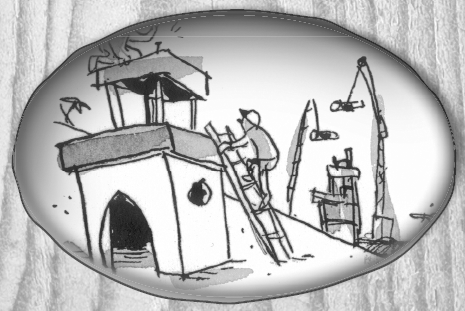
Despite the success achieved by Charlie Surfs' switch to the service sector, bank loan officers remained somewhat leery about providing funds for risky service sector businesses. Looking for a safe bet, they soon cast their eyes at the island's sleepy hut loan market, which seemed to offer a good source of low-risk loans.
Up until that point, the hut market had never figured prominently into the overall economic picture. The huts themselves were typically modest affairs well suited to the islanders' tropical lifestyle. But with prosperity growing and interest rates low, demand for newer, bigger and better huts began to emerge.
Traditionally, islanders would save for years, and then pay for a hut up front in full with cold, hard fish. But over time, the bank started making hut loans to the island's more secure borrowers. These loans meant that borrowers did not have to defer their purchases and could buy huts whether or not their savings equaled the purchase price.

Although such lending did not expand the island's productive capacity, or increase the borrower's capacity to repay (as a business loan did), these loans did have good underlying security. That was because, unlike a loan made to an entrepreneur with an unproven business idea, a hut loan came with a piece of solid collateral attached...the hut itself. If the borrower couldn't pay back the loan, the bank would take possession of the hut, which it could resell to pay off the loan.
Even with this collateral, there was no guarantee that the bank could get all its money back after such a sale. As a result of this risk, the bank demanded that borrowers come up with a substantial amount of fish for a down payment. This commitment would provide the bank with some assurance that the buyer would continue to pay. It would also limit the bank's losses if the borrower couldn't pay back the entire loan.
Some islanders resented the fact that access to hut loans was unequal. The wealthy usually got loans easily, but those who had no savings or poor credit had a much harder time. Some felt that the poor were being denied access to the island's upper echelons of wealth. Sensing a potent campaign issue, the Senate got into the game to fix the problem.
Arguing that hut ownership lay at the very core of the Usonian Dream, Senator Cliff Cod devised a plan where the government would ensure that everyone could get a hut loan. Not only would the Senate mandate ultra-low interest rates with very low down payment requirements, but it would stand behind the loans and pay the bank back if the borrower couldn't.
In order to facilitate the process, Cod created two agencies—Finnie Mae and Fishy Mac—to buy hut loans from the bank. The hut buyer would then pay back the agencies directly. The bank would immediately get back its principal, which it could use to make new loans (and be rewarded with a generous fee for its efforts). With the Senate guarantees in place, the bank dropped interest rates as it no longer needed the extra revenue to protect itself from losses due to defaulting loans.
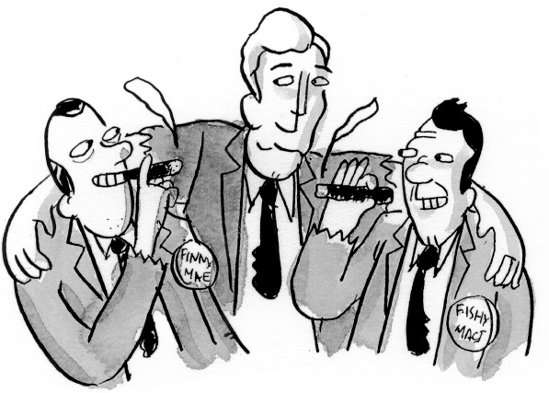
The hut lending program was a huge hit with the bank, which was able to make nearly risk-free profits. It was also popular among voters, who no longer had to save half their lives to buy a hut. Based on his shrewd maneuvering, Cod was rewarded with a nearly lifetime Senate term.
Another agency, Sushi Mae, was devised to underwrite loans for youngsters wishing to enroll in surfing school. Guaranteed tuition loans on the table enticed more and more islanders to brush up on their cutbacks and nose riding.
With easy access to Sushi Mae loans, Charlie Surfs was able to raise tuition rates aggressively, without worrying about pricing its customers out of the market. Soon, tuitions began rising much faster than the overall rate of fishflation. Most economists assumed that the higher prices simply reflected the increasing social value of a surfing degree.
To keep pace with tuition increases, Sushi Mae continually increased the size of loans it was willing to guarantee. In a few years, surfing school tuition became one of life's most daunting costs.
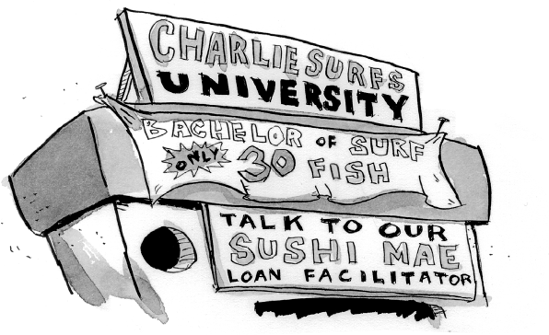
Similarly, with Finnie and Fishy on the job, the island's hut building, hut selling, and hut decorating industries took off. These activities sucked up more and more of the island's productive energy, without doing much to bring in any more actual fish or increasing anyone's ability to repay hut loans.
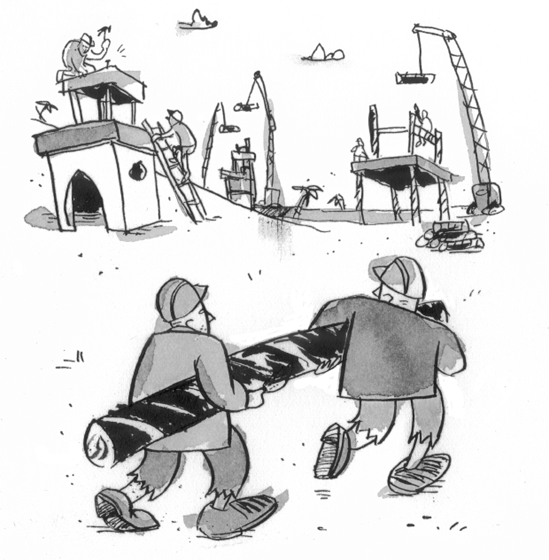
As interest rates for hut loans dropped due to the Finnie and Fishy guarantees, islanders were able to take out bigger loans. As a result, just like surfing school tuition, hut prices started moving noticeably higher. With steady price increases, islanders began to perceive hut ownership not just as an expense worth shouldering but as a vital investment. To guarantee a prosperous future, hut ownership was considered better than saving.
The Senate further stimulated the hut sector by declaring that profits made from buying and selling huts would be largely tax free, and that interest paid for hut loans could be deducted from the yearly fish tax. As a result, looking to buy and sell a hut for profit became a much more bankable financial plan than trying to start a business or saving for the future. Not surprisingly, the island got more new huts. But it also got less savings and fewer new businesses.
When the pace of hut price increases really gathered steam, loan amounts bumped into the limits that the Senate had placed on Finnie and Fishy loans. When that happened, Senator Cod inevitably stepped in, declared the fundamental soundness of both institutions, and urged the Senate to increase loan limits so that huts could remain affordable. He always prevailed.
The head honchos at Finnie and Fishy, both old friends of Cod, rewarded the senator's efforts with generous contributions to his reelection campaign and a sweetheart loan on his own hut.
Given that Finnie and Fishy paid a higher rate of interest to its investors than did the Fish Reserve Bank, the Sinopians piled some of their surplus fish notes into Finnie and Fishy. They took confidence from the fact that the Senate seemed to stand behind the solvency of the two lending institutions.
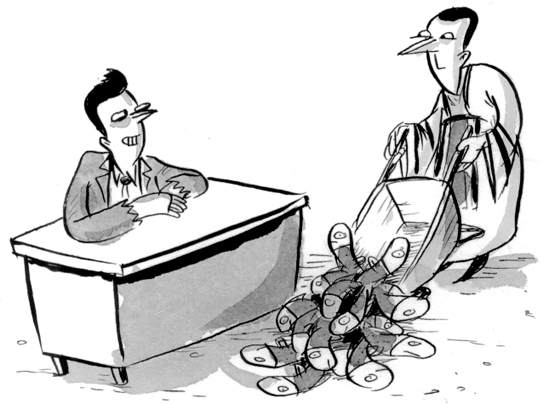
The influx of Sinopian investment fish into the hut loan market swelled the availability of credit and brought down interest rates even further. This meant bigger loans became even more affordable. In turn, the ease of getting a big loan allowed buyers to throw caution into the wind and bid up hut prices even higher.
Sensing the profit potential, Manny Fund VII jumped into the market with both feet. The descendant of the island's first venture capitalist noticed that there were some loans that were so ridiculously risky that even Finnie and Fishy wouldn't touch them. But given the mania for hut investment, he believed he could rely on the old Manny Fund panache to convince buyers that the loans were solid.
Manny began offering islanders a new type of loan, which he called "hut fish extractions," in which hut owners replaced existing mortgages with bigger loans on the huts that they already owned. The new financing would pay back the original loan and put the extra fish into the borrower's pocket. The rise in hut prices justified the bigger loans. With Manny's "fish-traction" loans, anyone who owned a hut could get his hands on essentially free fish!
With the relatively high interest that Manny charged to fish-traction borrowers, his investment fund was able to offer even better yields to its investors. Not wanting to be left out of the party, Fishy and Finnie asked Cod to let them buy these riskier, higher-rate loans as well. When the approval came through, the two agencies became the biggest lenders in the fish-traction market.
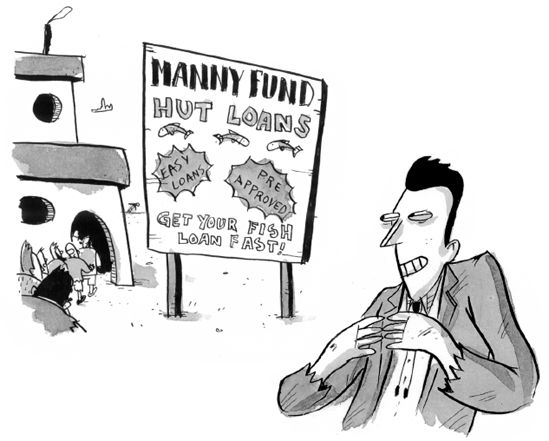
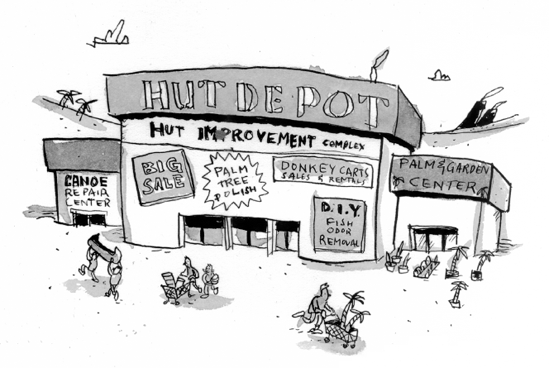
Fish equity extractions provided a huge shot in the arm to the hut improvement industry, which became a major focus of economic activity. Hut Depot, an islandwide chain selling primarily imported hut improvement paraphernalia, employed dozens of specialists to show the islanders how to make more money through the magic of hut improvement. It was widely accepted that every fish spent on hut improvement would result in two fish in higher sales prices. No one was really sure why this was so...but why question the professionals?
Huts became much more luxurious than ever before. Fire pits were lined with polished abalone shells; water buckets were pulled aloft on the finest silk ropes. Many huts were fitted with designer thatchings and came with built-in wide-screen windows.

Soon islanders began demanding not just primary hut residences, but also investment and vacation huts. Some islanders even built vacation huts on top of their regular huts.
But then a strange thing happened. With all the demand for huts created by fish-traction loans, low (or no) down payment requirements, tax-free profit policies, and all the fish showered on borrowers by the bank as a result of the Finnie and Fishy guarantees, hut prices really started to go wild. Prices had always gone up a few percentage points every year, but now they were going up by that much every month! Bidding wars broke out for even the dumpiest huts.
Things got to the point where traditional measures of affordability no longer applied. It used to be that islanders would pay no more than two or three times their yearly income for a hut. Now they were paying 10 or 20 times. People bought huts that they knew they could not afford in the belief that they could sell in a few years for far more than they paid. With that kind of profit potential, no downside risk, and oodles of government incentives including subsidized loans at artificially low interest rates, nobody could resist.
But the rapid rise in hut prices was a boon to the senators. The easy riches made voters feel wealthy and provided circumstantial evidence of wise economic leadership. Naturally the senators took every effort to keep the merry-go-round spinning. Ben Barnacle, and even the elaborately esteemed Ally Greenfin, assured all that there could be no such thing as a hut glut, because hut prices simply could not fall.
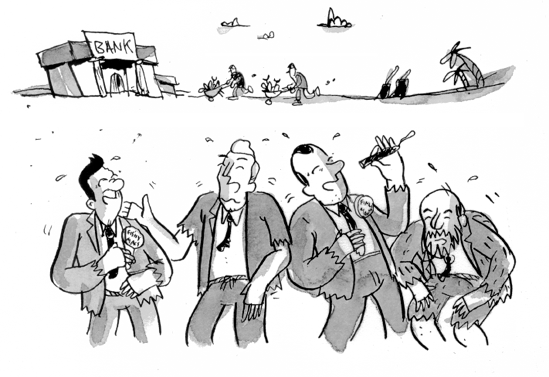
Not just politicians talked up the mania. The island's most respected private sector thinkers were the loudest cheerleaders. The dapper Barry Codroe had a popular stage show, where islanders discussed current events. The always optimistic Codroe dubbed the expansive era the "Goldfish Economy." Regular panelists like Carp Gaffer assured islanders that hard times were nowhere in sight and that bank policy had never been better. Another pundit, Dom Luskfin advised consumers to buy huts with both hands. One occasional guest, Piker Skiff, often brought in for comic relief, warned of the pending hut collapse. His foreboding elicited howls of laughter.
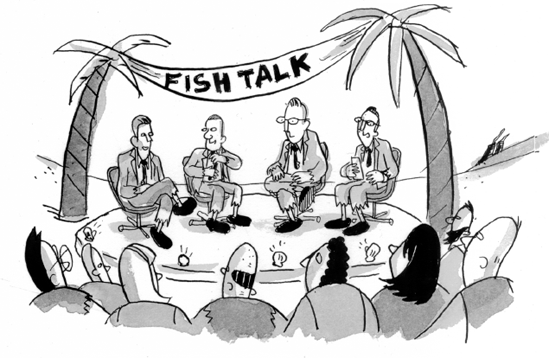
Now that it is painfully clear to everyone that the United States experienced the joy and pain of an inflating and collapsing housing bubble, we must take pains to remember that the vast majority of economists, government officials, and financial pundits could not see the calamity coming even as it stared them down at point-blank range.
It was as if all the meteorologists in the country failed to predict a category 5 hurricane when it was just 10 miles off the coast of Miami. Is there any more evidence needed to confirm the utter cluelessness of mainstream economic thinkers?
By any measure of sober valuation, home prices by 2006 had passed into Fantasyland. Valuations were disconnected from every gauge that had been designed to measure their affordability. None of the numbers added up. Yet somehow, economists came up with rationales that seemingly justified the ascent.
But people failed to see the agendas behind the cheerleading. Politicians wanted to keep voter confidence high through a sense of false prosperity; businesses wanted to keep consumers spending on products and services that they really couldn't afford; cable networks wanted to keep ratings high with optimistic hurrahs; and banks, mortgage originators, and real estate brokers wanted to continue making money on fees and interest. All of these interest groups had hired guns who put lipstick on the biggest, ugliest pig imaginable. And amazingly, their explanations were accepted.
So the good news is that now we have finally learned to be more realistic...right? Wrong. Even after the collapse of the mortgage market, people still don't understand how home prices are influenced by government policies. And so while the Bush and Obama administrations have committed massive amounts of government resources to prop up the deflating market, people still don't recognize how these trusses are simply extending the pain and setting us up for an even bigger fall.
